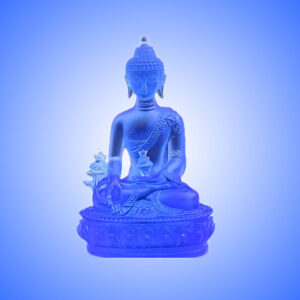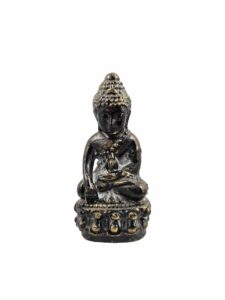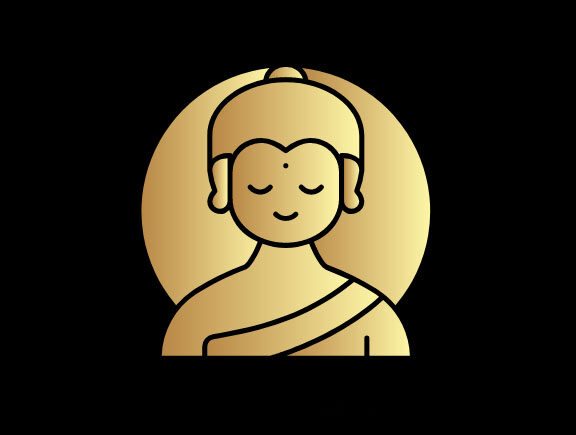
| Namo bhagavate bhaisajyaguru vaiduryaprabharajaya tathagataya arhate samyaksambuddhaya tadyatha: Om bhaisajye bhaisajye bhaisajya-samudgate Svaha |
|---|
Meaning:
“Homage to the Blessed One, The Master of Healing, The King of Lapis Lazuli Radiance, The One Thus-Come, The Worthy One, The Fully and Perfectly Awakened One, thus: ‘Hail! Appear, O Healer, O Healer, O Great Healer, O King of Healing!’ ”
The Twelve Vows of the Medicine Buddha
According to the Bhaisajyaguruvaiduryaprabharaja Sutra, the Medicine Buddha made twelve great vows while still a Bodhisattva. These vows represent his dedication to relieving the suffering of all sentient beings. The vows include:
- Radiance of Enlightenment: I vow that beams of light will shine from my body, lighting up all realms and helping all beings attain enlightenment.
- Healing Light of Lapis Lazuli: My light will illuminate the healing effects of lapis lazuli, enabling sentient beings to continue their journey toward enlightenment.
- Providing Material Needs: I will provide an unlimited supply of material goods to all sentient beings.
- Guiding to the Path of Enlightenment: I vow to guide all those practicing religious paths toward Supreme Enlightenment.
- Restoring Purity: Those who break the Three Pure Precepts will return to their purity upon hearing my name.
- Healing Physical and Mental Defects: I vow to heal those born with physical or mental defects, freeing them from sickness and suffering.
- Relieving Illness and Suffering: I will help all who are sick or suffering find healing upon hearing my name.
- Transformation of Gender: Women who wish to be reborn as men will achieve their desired rebirth and attain Supreme Enlightenment.
- Deliverance from Evil Paths: I vow to guide sentient beings trapped in wrong beliefs to the path of enlightenment.
- Relieving Physical and Mental Oppression: I vow to relieve the suffering of those oppressed physically or mentally.
- Providing Nourishment and Peace: I will provide food, drink, and spiritual peace to those suffering from thirst, hunger, and evil inclinations.
- Clothing the Needy: I vow to provide appropriate clothing to those suffering from extreme weather or lack of resources.
The Spiritual and Physical Healing of the Medicine Buddha Mantra
The Medicine Buddha, or Bhaisajyaguru, formally known as Bhaisajyaguruvaiduryaprabharaja, is a revered figure in Mahayana Buddhism. His name means “Medicine Master and King of Lapis Lazuli Light,” symbolizing his ability to heal both spiritually and physically. The earliest depictions of the Medicine Buddha were found in the ancient Gandhara kingdom, corresponding to modern-day Pakistan and Afghanistan.
The Medicine Buddha is typically depicted with an alms bowl or a medicine jar in his left hand, symbolizing his healing powers. In Tibetan Medicine Buddha imagery, a myrobalan plant may grow from the bowl, representing the Buddha’s power to heal all diseases. His posture, sitting on a double-tier lotus throne with his right hand reaching out, signifies his readiness to bless and heal all who seek his help.
The color lapis lazuli, a deep blue, is central to the Medicine Buddha’s depiction in Tibetan Thangka paintings and iconography. The lapis lazuli radiance has a purifying and strengthening effect, and visualizing this color while chanting the mantra is believed to increase its healing power.
How to Chant the Medicine Buddha Mantra
According to the Medicine Buddha Sutra, one should chant the Medicine Buddha Mantra 108 times while holding a cup of water. This blessed water can then be offered to the sick, helping them recover faster. The combination of chanting and visualizing the Buddha’s radiance is believed to bring both spiritual and physical healing.

The Significance of Phra Kring in Relation to the Medicine Buddha
The Phra Kring amulet, a representation of Bhaisajyaguru, holds great spiritual significance in the Buddhist tradition. It originated in China and has since become a popular symbol of healing in the amulet community. The Phra Kring Yai (large mold) is especially prized and symbolizes the healing powers of the Medicine Buddha.
The name “Phra Kring” comes from the sound the amulet makes when shaken, resembling the word “ring.” It is believed that hearing the ringing sound invokes good luck and spiritual protection from the Medicine Buddha. Additionally, the ringing sound is thought to connect the practitioner directly to the Buddha, ensuring that their prayers for healing and protection are heard.
Phra Kring amulets are highly valued by collectors, particularly those created in Wat Suthat. The most prized amulets are those that bear the name Pawares, a testament to their spiritual and monetary value in the amulet community.
FAQs about the Medicine Buddha Mantra
Q: What are the benefits of chanting the Medicine Buddha Mantra?
A: Chanting the Medicine Buddha Mantra is believed to bring spiritual and physical healing, promote mental clarity, and protect against harm. It also aids in achieving enlightenment.
Q: How many times should I chant the Medicine Buddha Mantra?
A: It is recommended to chant the mantra 108 times, particularly when blessing water for healing purposes.
Q: What is the significance of the Twelve Vows of the Medicine Buddha?
A: The Twelve Vows of Bhaisajyaguru represent the Medicine Buddha’s dedication to healing and guiding sentient beings toward enlightenment. Each vow emphasizes a different aspect of healing—both physical and spiritual.
Conclusion
The Medicine Buddha Mantra offers a profound connection to Bhaisajyaguru, the Buddha of Healing. Through the power of chanting, visualization, and mindfulness, practitioners can invoke the Medicine Buddha’s blessings for both themselves and others. Whether seeking spiritual growth, physical healing, or mental peace, the Medicine Buddha Mantra is a powerful tool in the Buddhist tradition, passed down through centuries.
Here are a few hand-picked articles for you to read next:
